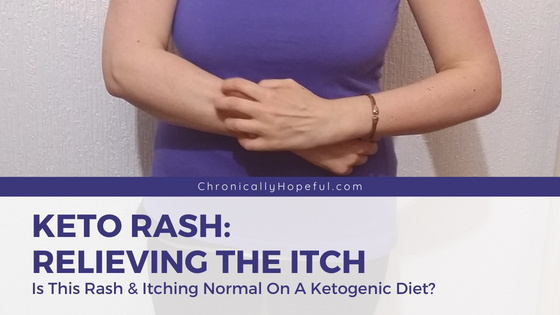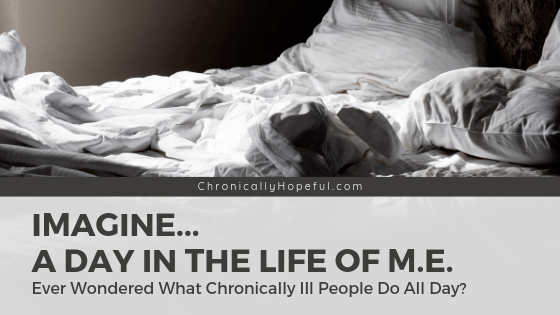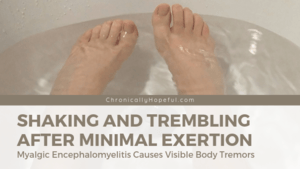If you’ve been following my journey for a while, you’ll be aware that I use Keto for ME/cfs management. I often get asked what this ketogenic diet has done for me. What benefits have I had? Why should somebody give up those delicious carbs and starchy foods? Are the benefits really worth the sacrifice? Should you try Keto for ME/cfs too?
In this post I’ll explain my journey so far. In short, in my opinion, the answer is yes – it’s definitely worth a shot! Let me tell you why…
Using Keto For ME/CFS
At the beginning of February 2017 I started my transition to the ketogenic way of life. It happened after reading just a part of Dr Sarah Myhilll’s latest book ‘Diagnosis and Treatment of Chronic Fatigue Syndrome and Myalgic Encephalitis‘. Dr Myhill specialises in treating patients with ME/CFS and is well loved and trusted among the patient community.
I decided to take a leap of faith, not really knowing the scientific ins and outs of this way of life, but trusting that she knew what she was talking about. The best part is that Dr M doesn’t ask you to do anything she doesn’t do herself. So to trust a doctor with years of experience studying and treating patients with this chronic illness, who also puts into practice what she preaches, wasn’t really that much of a leap!
I have since also bought her latest book ‘The PK Cookbook: go paleo-keto and get the best of both worlds‘. You can read my thoughts on this book here.
How Did I Transition?
My transition to Keto was probably not the most commonly chosen route. Most people choose to slowly lower their carb intake before going fully ketogenic, but I jumped into this new, very low carb, high fat way of life immediately. From a non-keto breakfast my mum went straight into keto for lunch and we didn’t look back (my family cooks for me as I’m not strong enough to cook yet).
Why I Took A Break From Keto
I stuck with it for 2 months before I decided to stop due to an allergic reaction to an unknown allergen. When I switched to keto I started eating things I didn’t usually eat, so it was bound to be something I had eaten causing the terrible itching all over my body – or so I thought.
Turns out my body probably has trouble eliminating histamine and some foods contain higher histamine levels than others. I simply had to modify my personal food list and was prescribed antihistamines to help eliminate the crazy itching.
I took 3 weeks off the Ketogenic diet to figure things out and plan what my shopping list and meal plans would look like on a low histamine diet and then hopped back into Keto in May. During those three weeks, I went back to eating the average high carb diet most people eat and boy did I pay for it!
Side-effects Of A High Carb Diet
My eczema came back within days, as did my joint pains and over the weeks my general pain increased to horrible levels. I had to start taking Naproxen again after being medication free for months. Apart from the pain, I also felt generally weaker and less energetic. Less clarity of mind with an increase in the dreaded brain fog.
My heart palpitations returned and so did the insatiable munchies! When I eat carbs, my body just doesn’t register when I’m full and I keep feeling hungry. This is probably how I managed to eat so much all my life and become so overweight.
It seems it was simply a chemical reaction that made my body malfunction and think it was always hungry. I’m sure there is actually a scientific explanation and name for it, but that’s the basics of what was happening. To my body, carbs are like kryptonite.

Some History About My Condition
My ME/CFS is quite severe, I’ve been housebound and mostly bedridden since April 2015. I had had short periods of improvement in the first year and again in the beginning of 2016, but they only ever lasted a few days to a week or maybe two. Then the decline would come again and I’d spend weeks or months in bed.
The steady decline started around June 2016 after a lovely period of improvement and a few outings. It reached the point where I was only able to shower, seated, once a week and I’d pay for those showers for days. My sister had become my full time carer, taking care of house and food and me whenever I crashed so low that I couldn’t even pull up my trousers or move my own limbs in bed. It was scary at times.
2017 has been spent mostly in my bed. I’d stopped doing art and crochet, I read less, I did less. Most of my time was spent reclined or lying down in my bed watching Netflix or scrolling through images on Instagram. Living through the camera lenses of other people. Recovering from my last shower or visitor or simply digesting my last meal… everything was just exhausting.
Moving To A New Home
As the months passed the excitement and fear grew as we were planning to move to a new home. I am always excited to move to a new house, I’ve always loved that, but this time would be very different. This time I was ill and would not be able to face even the presence of other people packing my things – I certainly was not able to pack them myself!
My amazing parents volunteered to do all the packing and cleaning and managed to secure the new house for us, in advance, so that I could escape the commotion in my old flat and my sister travelled with me to the new home.
This was mid-May 2017, just a few weeks ago.
During my last week at the old flat I had visitors, I had a shower (anticipating huge payback from a full day of travel and not knowing when I might be fit enough to wash again), and then the taxi and train journey to the new place. So much exertion for somebody who had been bedridden for months!
The amazing thing is that the expected flare never came! It took an entire day of travelling to get to the new area. On top of all the other activity I’d had that week, I expected some sort of payback, at the very least a few days in bed, completely out of it physically and in a lot of pain, but none of that happened!
I had been out of my house just a week earlier for a doctor’s appointment, and that was only 20 minutes away – that gave me terrible payback just like every other outing before, but not this time. The only difference was that this time my body was not only in ketosis, but it had finally fat adapted.

My Ketogenic Diet, Round 2
I had already restarted the ketogenic diet about 2 weeks before the move, at the start of May. Within 3 days my eczema was almost gone and my joint pains vanished soon after that. As the weeks passed, all the keto benefits reappeared.
I was surprised it happened so quickly since the first time I started the keto diet, it took over a month for any benefits to appear at all, and they were not as pronounced.
Benefits I’ve Had From Being Fat Adapted
- My eczema cleared up
- The heaviness in my limbs that I used to wake up with has reduced noticeably, making it easier to move first thing in the morning. Used to take hours to wake my body up in the mornings, felt like I was paralysed at times.
- No more heart palpitations and breathlessness from simply brushing my teeth.
- I have been able to bath every third day rather than only once a week!
- My hunger is under control. I eat only twice a day now and am fully satisfied. Weight stable.
- I have periods of great mental clarity, the fog is no longer constant. Such a relief!
- My joint pains vanished within days of reaching ketosis.
- My general pain has decreased considerably. Still increases upon exertion, but less severe.
- I’m no longer bedridden! I have been spending my days in the living room rather than spending 24/7 in my bed. I walk around my new flat during the day, still resting a lot.
- Since 1 June 2017 I have managed 1000 steps a day almost every day. At the start of May I was struggling to make it 7 steps across my room to the toilet and back. This is such an accomplishment! I am so pleased to be able to move more.
- I have been able to occasionally help my sister prepare a dish in the kitchen or seated at the dining room table where I now enjoy all my meals, rather than eating alone in bed.
- I can spend weekends with my family when they come to visit, I no longer have to stay isolated in my room. I do sometimes still wear my noise cancelling headphones, but this is also a huge improvement for me!
- I’ve been able to start drawing and lettering again, my arms are less heavy and shaky.
These are all the benefits I have noticed after becoming fat adapted in my second week of ketosis. I believe it happened so quickly because I had already been in ketosis just a few weeks prior, so the switch happened faster than it would have if I’d not been in ketosis prior to starting in May.
Recommendation
You can see why I highly recommend trying the ketogenic way of eating. I praise God that I found Dr Myhill’s book and decided to give it a good go.
I had decided right from the start that if I did this, it would be for at least 6 months. You cannot play with dietary changes, you have to commit and give it your all, else you cannot be sure the results you’re getting are legitimate.
Although I started in February, this is only my fourth month eating this way. I hope these benefits will continue as time goes by. I will stay on this way of eating for life even if this is the best I will get. There’s no way I’m going back to carbs after seeing the dramatic side-effects I had.

Pin This Post!
If you suffer from chronic illness; pain, inflammation, brain fog, fatigue, etc – I hope you will at least consider the ketogenic way of eating as a means to manage your symptoms, but also to help heal your body. This diet is healing, anti-inflammatory and so satisfying. It’s absolutely worth a shot!
So, How’s My Diet Going Now?
I frequently get messages asking me for updates on my diet, whether it’s my Keto journey or my Low Histamine journey. So this is where I will periodically share a short update and you can see how this way of eating is affecting me over time.
For context: I fell ill with ME/CFS in 2015 and became housebound. I started Keto in early 2017 as a way to reduce my symptoms, by the end of the year I had developed severe Histamine Intolerance issues, so I adjusted my diet to Low Histamine Keto. Here are my updates since then:
Update – December 2017
Histamine Intolerance: My itching and hives are under control now. I got rid of the hives by fasting for 24hours a day for three days straight. This means that every 24 hours I’d have a 1hour window in which I would eat my meals according to this plan of action. Within 3 days the hives were gone. I continued for almost 2 weeks eating once a day only. Please keep in mind that I am on the ketogenic diet, which keeps me satiated, drinking a lot of water and electrolytes helps too.
After the initial 2 weeks, I started reintroducing a second meal, more of a high fat and protein snack in the evenings, so my fasting window reduced from 24 hours to 16. I did this for most of October, after which my itching had completely gone away and I could start reintroducing some foods again. In small quantities.
My itch has only returned, very mildly, since we switched our winter heating on in the house about a week ago. Heat is a trigger for my histamine response, but cold is bad for my chronic pain and muscle shakes caused by ME/CFS, so I’ll put up with the slight itch and adjust my meals accordingly to keep it under control.
Update – August 2019
Low Histamine Keto: There were only a few itchy episodes in the winter of 2017. The whole of 2018 was incident free, except when I ate spinach which seems to give me an instant reaction almost every time I eat it.
2019 has been almost completely incident free too, except two reactions which I later realised were caused by a peanut flavoured protein shake I was having for lunch. I rotate through a variety of flavours and only had reactions on the peanut flavour days. Since stopping that shake, I have not had any more reactions.
I continue to eat a low histamine diet most of the time, but am able to enjoy a couple of high histamine foods daily in small doses. I also continue to use quercitin powder sprinkled on one meal a day and at least one serving of olive oil a day. I also still take the salt drinks as supplementing electrolytes is important for Keto too.
Update – 2020 to Present Day
Keto And Histamine Intolerance: I’m still on the ketogenic diet, but have been able to reintroduce many high histamine foods on a regular basis, including spinach and even the occasional treat including peanuts – all without any reactions. I still take antihistamines, salty cocktails and olive oil daily.
During pollen season I do have to be more careful with the amount of high histamine foods I eat as my levels are already higher at that time of the year and reactions are easily triggered if not careful. The rest of the year I can be relatively carefree about histamine levels.
My ME/CFS has not continued to improve with the keto diet, I’d say it’s probably reached a plateau, but it absolutely gets worse when I go out of ketosis on my rare cheat days. So I maintain this way of eating to have a better quality of life.

Let’s Stay In Touch
Housebound Lifestyle: Facebook | Instagram | Twitter M.E. Awareness: Facebook | Instagram | Twitter | The ME/CFS Community Vibrant Hope Art: Facebook | Instagram | Twitter Support My Work: Buy My Art | Shop My Favourite ThingsOr if you’d like to send me something, here’s my Amazon Wishlist – Thank you!
![]()
This blog was designed using Thrive Themes.















Hello, I am glad i found your blog. I am newly diagnosed and I am in the devastating stage trying to cope. You blog give me a little hope and I am rooting for you. I also started the ketogenic diet. Are you also on any supplements? Thanks
Hi KaLa,
I’m sorry you also have to deal with this debilitating illness, but there is hope for recovery and many ways to manage symptoms and improve quality of life. I’m glad you’ve found my blog and I hope that you will find some useful tips and information here. Feel free to ask any questions, there is a contact form for private messaging too.
I am taking supplements which I will write more about soon, but the main ones I’ve found beneficial are MSM for pain management, Omega 3 for joints and B complex for energy. I feel it when any of these supplements run out.
I highly recommend Dr. Myhill’s book (link in the sidebar) as it will outline the diet and supplement protocols in detail. There are many more supplements she recommends, but I cannot currently afford them all, so I’m doing the best I can for now and am very happy with the result so far.
I am also taking vitamin D3 (just started a week ago) and Magnesium citrate currently as well as electrolytes and celtic salt sublingually a couple of times a day. The salt actually helps with energy levels and hydration/absorption.
Hey there! Firstly, I’d like to say well done for getting to where you are now, it’s an incredible achievement – I know how even 50 steps a day can feel amazing so well done on getting to 1000. Also, I love your positive tone, something I have found to be very lacking in other stuff I’ve read online.
I’ve had M.E for 12 years – relapsing and remission, currently in the worst relapse I’ve had since I first became ill and I’ve been bedbound for 3 months and counting… I’ve just found Dr Myhill’s book and interested in the keto diet (that’s how I found your blog!) Did you just start with the meal plan from the book? And did you stick strictly to just that? Thanks so much and keep going, you’re doing great! x
Hi Suzi, Thank you!
Sorry for this very late reply, I see I somehow missed your comment.
I’m glad you have found Dr M’s book and are going to try Keto. I did start on the sample menu plan in the book, but soon found that I was unable to eat so much. I ended up halving the portions! Digestion was just too exhausting, I couldn’t handle so much food all at once. After about a week of eating from that plan, I drew up a list of variations that my mum could choose from for each meal. I have shared the list on my blog – here.
In May when I restarted keto, I also started planning my meals in the MyFitnessPal app. I had calculated what my ideal macro-nutrient ratios were and used the app to make sure each day’s meals would provide the correct amount of fat and protein as well as keep my carb levels below 20g a day which is the easiest way to ensure fat-adaptation. This might have aided my quicker results the second time round. I talk about the macro calculations in another post – here.
Also, my initial 2 months were paleo-ketogenic, so dairy free, but when I restarted in May, I added back just a few dairy products to help meet my fat and protein goals due to my allergic reaction forcing me to eliminate a few fat and protein sources from my diet. I am currently considering reducing the amount of dairy I consume, I might just have it as an occasional treat, like if there’s a special recipe I’d love to try, etc.
I hope this answers your question. Please let me know how you get on!
So nice to read how well you’ve been doing! What a great thing to read!
I also have CFS but not to the same extent that you have. I was a big doer before and for the last 3 years haven’t really been able to do anything. It’s so lovely to read that this has helped you and given me determination to restart my carb free way of living which is what I used to do just because I liked it. I just have to get through the initial days of detox from the carb addiction. Many thanks for your post!!! Best of luck.
Hi John, Thanks for stopping by. The first few days of low carb are hard, but it’s so worth it once the body fat adapts properly. I hope you will also experience some improvement with Keto. I was so sceptical of this high fat way of life for years, but I’m a firm believer now!
Please do keep in touch if you try it – I’d love to know how you get on.
Have a great weekend!
Hi Dear, Having CFS/ME and mostly housebound for 3 years I finally transitioned from low fat vegan to Dr Myhills Keto diet but made it low lectin too (dr Gundry’s diet for CFS) . I am experiencing more anxiety , more dreaded fatigue and irritability but having read your very informative blog it has made me realise that the side effects early on are real. They call it the Keto flu but for us CFS sufferers it is 10 times worse. By the way, its July 2018 how are doing on the keto diet? Wishing you the best! Nick
Hi Nick, Thank you for stopping by. How long have you been on this new diet? It really does get worse before it gets better. I am still on the ketogenic diet. I initially was dairy free too, but only for the first 2 months I think. After that I continued with dairy. I am doing okay, still housebound but more active and much less pain than I had on a higher carb diet so I stick to it! I haven’t had much more improvement from continuing on the diet, but I do get drastic deterioration if I move from it, so I will keep at it and keep trying other things over and above the keto diet to see if I can improve any more. It’s a long, slow process, isn’t it?
Hi! Does this keto diet includes animal products as well? How do you feel these days? Are you still on keto diet?
Hi Florin, yes keto generally relies on animal protein and fats although I know there is at least one vegetarian, maybe even vegan, facebook group for keto, so if that’s an issue, then I suggest looking them up. I am still on keto, going strong since Feb 2017. I’m no longer confined to bed and can walk around the house daily, much less pain, no more of that heaviness in the morning, and I even get out into the garden regularly now. It has helped a lot, although I would still consider my condition severe, my quality of life is much improved. I cannot afford to go off keto for more than one rare day of treats, that’s for sure.
Hi, thank you for sharing your story. I’m really interested in how it all worked our for you in a long term, with your diet. Pls share. 💜
Hi Eva, Thank you for your interest. I have updated my posts about Keto for ME/CFS by adding an update section below where I will periodically add an update to keep track of progress over the years. I hope this helps.
Thank you for sharing your journey. I am struggling with histamine issues amongst many other issues, I think sibo is the main cause of the histamine intolerance. Do you mind sharing which protein powder you can tolerate, I thought most were high histamine other than hemp. Thank you.
Hi Kiley, I use 97% Beef Protein Isolate which I get from Bulk (you’ll get 35% off your first order if you use that link) and I also use Beef Collagen Protein (Amazon link). I buy both unflavoured as I have had reactions from the flavoured Beef Isolate powder. Both of these products are clean, meaning no added ingredients, just the beef proteins.
Generally, even at my worst, I didn’t have any issue with meat – I only had to stay away from heavily processed sandwich meats and tinned meats.
As always though, Histamine Intolerance is different for each of us, you will have to try something for yourself to see how your body reacts. If your histamine load is high at the moment, then it might not work for you, but it might at another time. It’s all trial and error unfortunately. I hope you find what works for you.